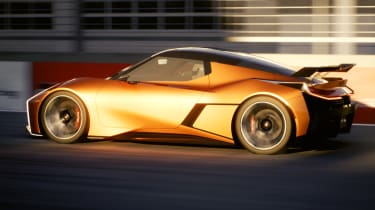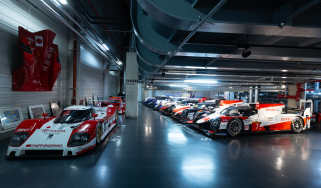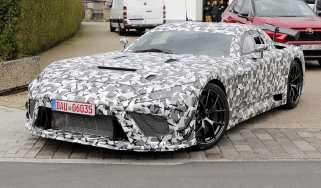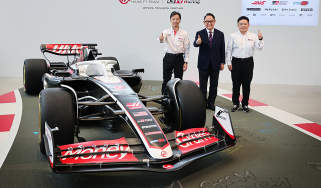Toyota’s GR division hasn’t given up on combustion engines just yet
Toyota’s Gazoo Racing division will continue to investigate hydrogen-fuelled engines for road-going performance cars, as well as developing pure electric GR performance cars

Toyota has confirmed it is studying the feasibility of hydrogen-fuelled, combustion-engined performance cars within its GR division. At the same time, its engineers are also working on new pure-electric, battery-powered models to wear the GR (for Gazoo Racing) name, as part of Toyota’s ‘multi-pathway’ approach to future power sources.
Speaking during Toyota’s annual Kenshiki forum event, held in Brussels, GR company manager for vehicles Masahito Watanabe told evo:
‘We still think that the internal combustion engine still has some potential. Of course we will be trying to comply with all the applicable laws according to the regions in each country but we don't want to give up just yet; because if you consider the internal combustion engine, there's still hydrogen combustion that can be part of the zero-emission part of [a company’s powertrain] line-up. So I think there's going to still [be a chance to] continue [with combustion-engined road cars].’
As to whether it will be possible for future GR customers to fill up with hydrogen fuel easily in the near future, Watanabe-san commented: ‘We still believe that there's a lot of potential to be had from the hydrogen combustion engine itself but we know that the infrastructure is woefully insufficient. This is a common issue across many different countries, and we completely appreciate that. So what that means is that we won't be able to commercialise the hydrogen combustion engines just right at this moment.
‘However, having said that, if you have a look at some of the movements that have been put forward in Europe, the US and Japan – and this is not just government [movements] but also private companies are now working towards increasing the hydrogen infrastructure. So we are looking out for that, and what we want to do in the end is to provide as many options as possible to our customers. So we will be continually developing this hydrogen internal combustion engine as part of [that approach].’
GR’s engineers are currently trialling liquid hydrogen-fuelled engine technology in a Corolla racing car campaigned in endurance races in Japan (with Toyota chairman Akio Toyoda among its drivers), and Toyota has committed to the upcoming hydrogen fuel class in the Le Mans 24h race, expected to be introduced in 2027.
At the 2023 Le Mans 24h, Toyota exhibited the GR H2 Racing concept, a 1:1 scale model of a hydrogen-fuelled prototype racing car created as a statement of intent. It has also committed to continuing its programme of hydrogen fuel-cell powered electric vehicles, including road-going passenger cars such as the Toyota Mirai and Toyota Crown FCEV. Speaking at the Kenshiki event, Matt Harrison, Toyota Europe’s COO, suggested that a hydrogen-engined Toyota may be campaigned in the Dakar rally ‘in the not too distant future.’

GR company manager Masahito Watanabe emphasised that the stresses of motorsport are core to developing potential hydrogen-engined future GR products, and GR products in general:
‘The provenance of Gazoo is that you have people working on the frontlines of motorsports,’ he told evo. ‘Those people will have undergone training and then they will then try to make really strong and competitive cars and that's where it came from. Hydrogen internal combustion is also going through the same process where, because you are racing, people will then face daily technological issues as they participate and then those will be solved on a daily basis. Our expectation is that those same people will then use the knowledge that they have accumulated to make great progress.’
Watanabe-san also confirmed that GR’s engineers are at work on pure electric performance models for the near future: ‘We still see high possibility for BEV (battery electric vehicles) as sports cars, as shown in the Toyota GR FT-Se concept car,’ he said. ‘That's still a concept at the moment. But what we want to do is pursue the multi pathway that we have been talking about – in motorsport and sports cars in general.’
Although Watanabe-san reiterated that the low, lithe FT-Se sports car ‘is just a concept’ for now, he told evo: ‘We don’t know if it’s going to be that particular car or something else – but we will be definitely looking for battery EVs within the [GR] line-up that can provide that fun-to-drive [character] in the future. So we're hoping that at some stage we'll be able to find something like that.’
The FT-Se concept is nominally designed around Toyota and Lexus’s upcoming ‘gigacast’ modular architecture and new Arene operating system software. The company has been examining ways to combine a pure-electric powertrain with sound, and Harrison told guests at Kenshiki that Toyota customers may be able to download the engine sounds of their favourite cars to future Toyota electric cars.

Watanabe-san confirmed that GR is working on different approaches for EV soundtracks:
‘We've been making a lot of battery EV prototypes. And we've found out that [driving] with sound and without sound has a huge impact on that fun-to-drive feeling. This is something that we have tangibly felt in our development. And we're still working on developing a sound that gives you that uplifting feeling that matches with the dynamics of the car. This is still in consideration.’
Toyota spokespeople have intimated that in the further future, it may also be possible for Toyota EV customers to select drive modes which mimic the vibrations of a combustion-engined car, or even download packs to resemble the vibrations or even handling characteristics of their favourite cars.
Watanabe-san cautioned such technology is still some way off:
‘You can appreciate engine vibrations are very complex and intricate,’ he told evo. ‘I think the technology available at the moment is insufficient to really satisfactorily reproduce those things, but this is being developed. If we look towards the future, what we want to do is to be able to provide that type of feeling in battery electric vehicles; this is still under development. Because we want to provide those battery vehicles with something that resonates with emotion, that resonates with the five senses. So this is something that we will definitely be looking at but current technology is insufficient to be able to provide.’
To that end of engaging with the senses, general manager of Lexus Electrified Shinya Ito told Kenshiki attendees that the system to simulate gearchanges in electric cars, as fitted to prototypes recently, is being ‘seriously considered’ for production.
> Lexus in development of a manual transmission for electric cars
‘This crazy idea – to recreate the joy of driving a manual car with a clutch pedal and gearlever in a BEV including the possibility to stall, and roll back from a hill start, with engine sound – now we are seriously considering offering [this] ‘manual BEV’ [system] in production models based on feedback,’ Ito-san said.
Watanabe-san says the system is being ‘considered’ for future electric GR products, though not confirmed. ‘In terms of the manual transmission for battery EVs, we have it within the scope of possibilities, that's something that we can introduce,’ he said. ‘We're considering whether this will be appropriate for those types of vehicles in the future.’







